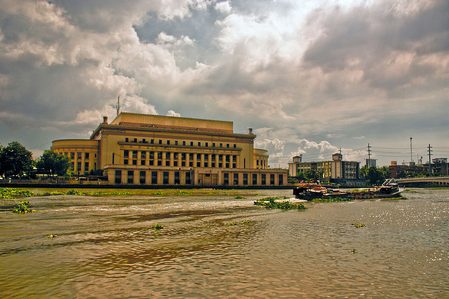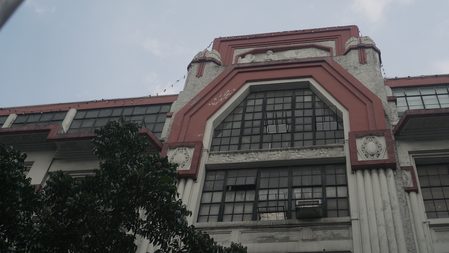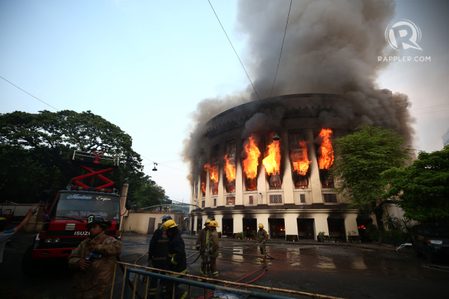SUMMARY
This is AI generated summarization, which may have errors. For context, always refer to the full article.
![[OPINION] The Manila Central Post Office will shed its old, burnt skin and become new again](https://www.rappler.com/tachyon/2023/05/manila-city-post-office-fire-may-25-2023.jpg)
Tragically, the historic Manila Central Post Office suffered a massive fire on May 21. The gorgeous neoclassical building had stood proudly on the banks of the Pasig for a century and counting. Unfortunately, this five-alarm fire is nothing new and is a symptom of fundamental flaws in urban design and safety regulations. Fortunately, however, its regeneration is just as inevitable.
Manila is a city that is constantly going up in flames. It was one of the most thoroughly destroyed cities by the end of World War II. One of the many buildings that was damaged during the Battle of Manila was this very same one, which was designed by legendary architects Juan M. Arellano and Tomás Mapúa.
Manila’s destruction during the war was intentionally caused by American forces, an ally. It was a case of the former American colonial occupier — who “won” the city like loot in a poker game from the previous Spanish imperial occupiers — destroying innocent lives and irreplaceable architecture to release the city from the Japanese occupiers’ iron grip, and who also had their own flavor of arson. Before all of that, during the Kingdom of Tondo, the Spaniards, led by Martín de Goiti, set fire to the Bayan ng Maynila, which also occurred in the month of May. Filipinos are always getting caught in the middle of foreign meddlers and exploiters.
However, that’s History with a capital “H,” and I can’t relate to any of that on a personal level. In this incident and in many other major fires since the mid-20th century, we can’t blame foreign occupiers or war. We can only blame our own collective shortcomings when it comes to fire hazard preventions.
Then there’s the lack of building codes and the enforcement or updating of any existing regulations. If you want to go down a rabbit hole, just look up the countless studies showing Metro Manila’s poor urban planning, which is fueled by a constantly ballooning overpopulation in tandem with cash cow opportunities, when real estate developers create more buildings with sub-standard materials. On top of that, there’s simply the general mishandling of historic sites.
Having said all that, let’s go back down to the street level. My own personal history with the MCPO isn’t substantial or direct. I’ve never even been there in person. My connection to that now-charred building — that is still somehow architecturally regal — is the fact that I used to write letters to a woman I loved in Quezon City, which has its own central post office. Nonetheless, I’m sure our letters had to go through the Manila Central hub at some point. In any case, the Manila office is the headquarters and the “brain” of the country’s postal operations.
I look at the photos of the flames puffing black smoke signals into the vast Manila sky like a distress call to the heavens, and I’m reminded that this resilient city has seen this same scene many times before. So much so that Manila should buy the name “Phoenix” from Arizona.
All those letters of longing, those words immortalized in ink, those sentiments from loved ones and friends throughout the decades have passed through the post offices of Metro Manila. I remember when my parents used to receive letters in the US from family back home. The red, white, and blue stripes on the edges of the envelopes were an icon of my youth.
Kumusta na kayo diyan sa New York?
May sakit si Nanay.
Marunong pa ba mag Tagalog si Michael?
Sana makauwi kayo ngayong Pasko.
Throughout the decades, before messenger apps, Filipinos sent and received letters to and from each other, reinforcing the threads that tethered our global diaspora back to the homeland.
Most times, letters contained joyous announcements like a new addition to the family, an upcoming wedding, a birthday greeting, or a Christmas gift. Sometimes, they carried bad news like a dark cloud looming over the horizon telling sailors that a storm is brewing.
Then there were those other times when two 20-somethings exchanged letters across the Pacific, slicing the hemispheres with paper cuts. Those thin pieces of paper were folded with precision and thoughtfulness like origami. Within them contained secrets that had never been shared with anyone else before or after, promises that had been kept and broken since then, and anxieties over an uncertain future, which both writers had dreamed of being beautiful, regardless of what it contained.
The Manila Central Post Office will shed its old, burnt skin and become new again, just like all the other buildings that have suffered the same fate many times before, just like those letters that have turned into ash. There will be new words to be written, read, and kept close to the heart. – Rappler.com
Michael Raqim Mira is a writer, photographer, and videomaker based in Texas with roots in Quezon Province. His editorial work has appeared in various local publications in the United States and the Philippines. You can find his projects at www.michaelrmira.com.
Add a comment
How does this make you feel?



There are no comments yet. Add your comment to start the conversation.